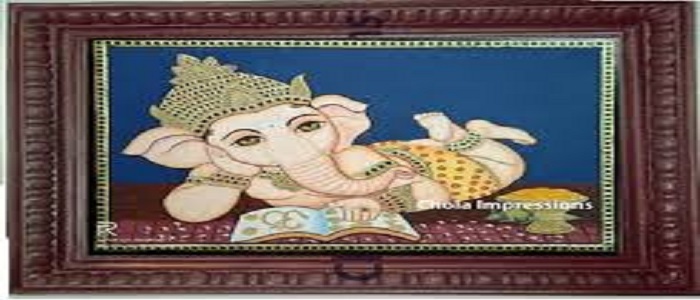Tanjore paintings have begun to find a home in luxury living spaces as well as corporate offices, when they were traditionally used to decorate prayer rooms, attics, and other places of devotion. The market for eye-catching Tanjore paintings, notably Ganesha, is fast expanding because to the increased enthusiasm of art enthusiasts, collectors, and nouveau riche buyers.
While you get an idea of what Ganesha Tanjore’s paintings are- you can also get to see the display of the work of landscape artists.
These ageless paintings, which combine holy majesty with earthy sensuality, have remained largely unappreciated. It follows a different and unique pattern than other traditional Indian art styles, with dense composition, surface richness, and a brilliant palette. In general, ganesha tanjore paintings are divided into two categories: compositions or scenes from the Puranas and religious epics, and depictions of deities as they are dedicated in temples.
Let’s go a little further to learn more about this beautiful art form:
Tanjore Paintings’ History
It is the original art form of Thanjavur (also known as Tanjore), a city in Tamil Nadu, and is one of the most prominent styles of traditional south Indian style paintings.
Developed during the Marathas’ reign of terror in the 16th century. Between the 16th and 18th centuries, it is thought that the Rajus communities of Thanjavur and Trichi, as well as the Naidus of Madurai, patronised this magnificent art form.
Tanjore paintings were generally painted on seasoned wooden boards of mango or jackfruit trees that symbolised affluence, as well as on some uncommon mediums including murals, ivory, and manuscripts, with a basic pattern, imposing figures, clean contours, and brilliant colours.
Later, rubies, diamonds, semi-precious stones, pearls, and glass pieces were added to the design to give it a three-dimensional aspect.
Tanjore Painting’s Creation
Tanjore paintings are known as Palagai Padam (‘palagai’ means wooden plank and ‘padam’ means picture) because they are mostly done on solid wood planks.
The foundation preparation, which is commonly formed from a piece of cloth and placed onto a wooden base, is the first step in making Tanjore paintings.
The base is also primed with a mixture of white lead, copper sulphate, and kanji (rice gruel) or a mixture of zinc oxide, chalk powder, and a water-soluble adhesive such as Arabic gum (usually obtained from the bark of Karuvelam trees).
The drawing is drawn and painted in vibrant colours, the majority of which are vegetable dyes (such as red ochre, yellow ochre, chrome yellow and indigo). Rich tones, such as deep green, deep blue, or crimson, or mixtures of red and green or red and blue, are generally used as the backdrop.
Final Thoughts
Tanjore art has progressed over time, with the use of synthetic colours and embellishment of gold, semi-precious stones, and glass bits.
Though the style has evolved, the purity and fundamental skill of working with rich colours has remained the same, as has the painting’s aesthetic appeal, which can captivate everyone!



